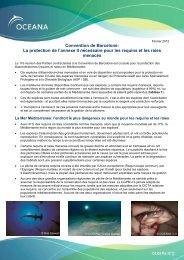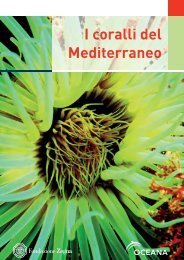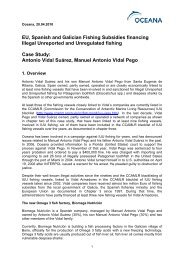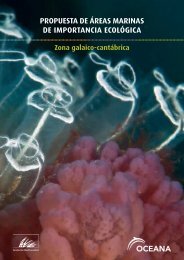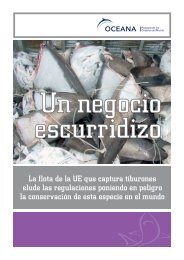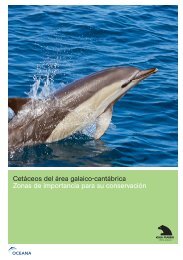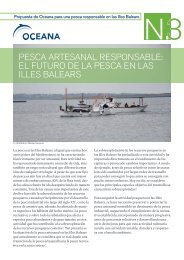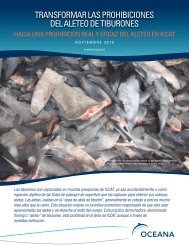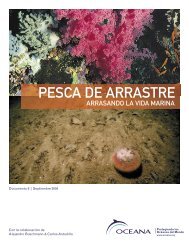Download - Oceana
Download - Oceana
Download - Oceana
You also want an ePaper? Increase the reach of your titles
YUMPU automatically turns print PDFs into web optimized ePapers that Google loves.
CORAL GARDENS<br />
OSPAR DEFINITION<br />
According to the OSPAR background document “Case Report for the OSPAR List of threatened and/or<br />
declining species and habitats”, “coral gardens” are a relatively dense aggregation of colonies or individuals of<br />
one or more coral species, supporting a rich associated fauna of benthic and epibenthic species. Coral<br />
gardens can occur on a wide range of soft and hard seabed substrata. Following the definition given by ICES,<br />
soft- bottom coral gardens may be dominated by solitary scleractinians, sea pens or certain types of bamboo<br />
corals, whereas hard-bottom coral gardens are often found to be dominated by gorgonians, stylasterids, and/or<br />
black corals.<br />
Non reef forming cold- water corals can be found as shallow as 30 m depth and down to several thousand<br />
meters.<br />
The coral garden communities are made up by different taxonomic groups: leather corals (Alcyonacea),<br />
gorgonians (Gorgonacea), sea pens (Pennatulacea), black corals (Antipatharia), hard corals (Scleractinia) and<br />
stony hydroids (lace or hydrocorals: Stylasteridae).<br />
Scleractinian corals such as Lophelia pertusa, Madrepora oculata and Solenosmilia variabilis may also be<br />
present but not as a dominating habitat component. These corals, if present, occur only as small or scattered<br />
colonies. Habitats where colonial scleractinians dominate are defined as coral reef.<br />
Densities of coral species in the habitat vary depending on taxa and abiotic conditions. Scientific investigations<br />
indicate that smaller species can occur in higher densities compared to larger species and some of them<br />
containing several coral species can reach densities between 100 and 700 colonies per 100m 2 . (E. g.<br />
Acanthogorgia sp.: 50-200 colonies per 100 m 2 ; Paragorgia sp.: 1-2 colonies per 100 m 2 ). Currently it is not<br />
possible to determine threshold values for the presence of a coral garden as knowledge of the in situ growth<br />
forms and densities of coral gardens is very limited, due to technical or operational restrictions. Moreover, the<br />
densities of developed coral gardens vary with taxonomic composition of the habitat forming corals. Visual<br />
surveys techniques will hopefully add to our knowledge in the coming years.<br />
OSPAR Regions where the habitat occurs: I, II, III, IV, V<br />
OSPAR Regions where such habitat is under threat and/or decline: all where it occurs<br />
Habitat occurs within each of the following deep seabed EUNIS types:<br />
A6.1. Deep-sea rock and artificial hard substrata<br />
A6.2. Deep-sea mixed substrata<br />
A6.3. Deep- sea sand<br />
A6.4. Deep-sea muddy sand<br />
A6.5. Deep- sea mud<br />
A6.7. Raised features of the deep sea bed<br />
A6.8. Deep sea trenches and canyons, channels, slope failures and slumps on the continental slope<br />
A6.9. Vents, seeps, hypoxic and anoxic habitats of the deep-sea<br />
2



